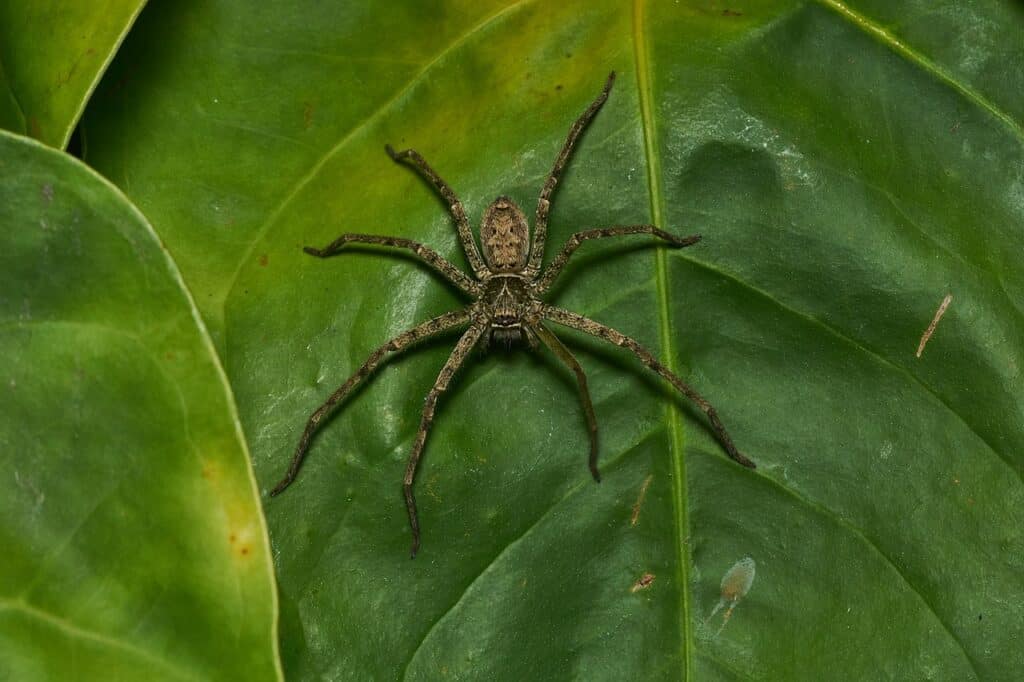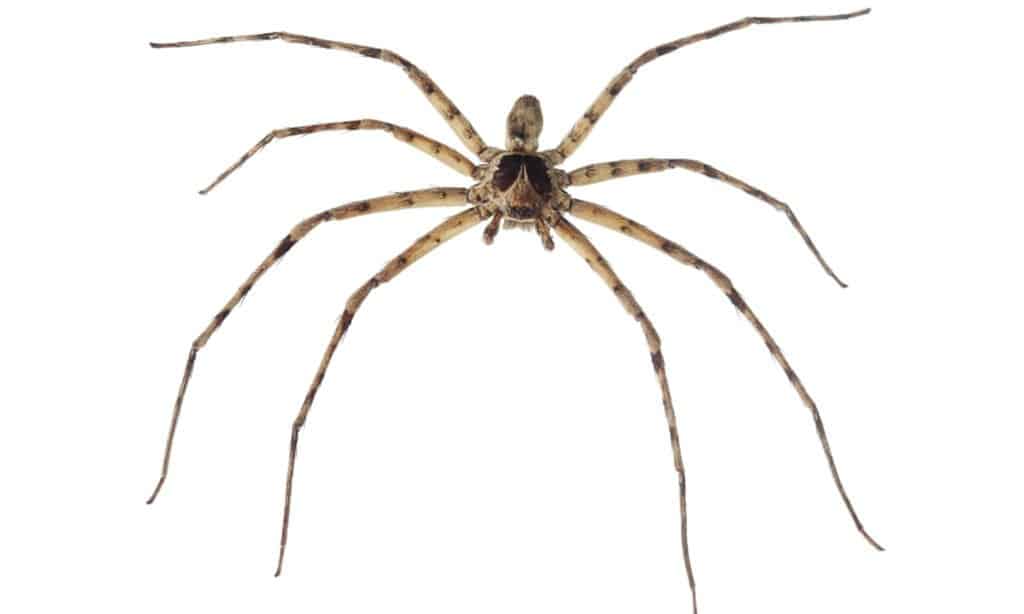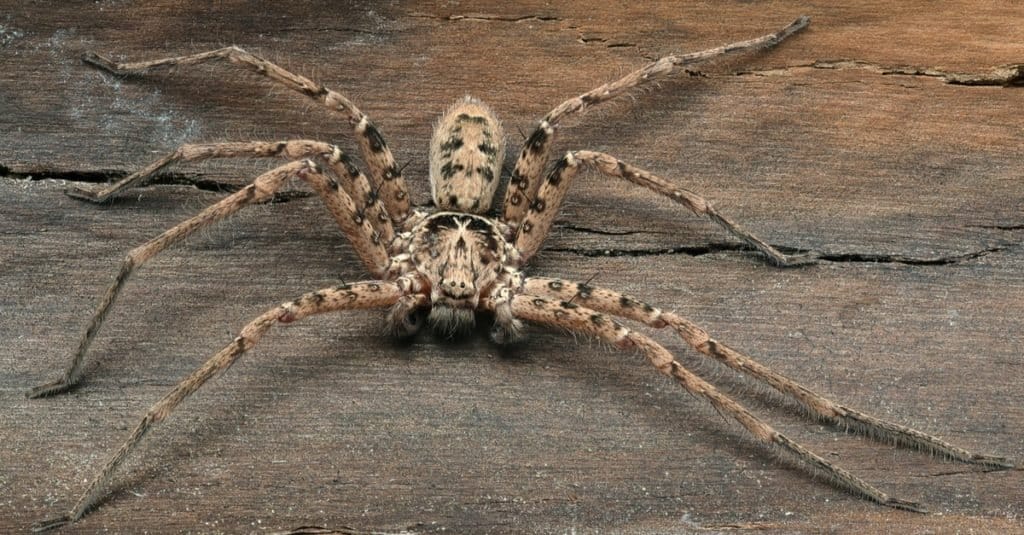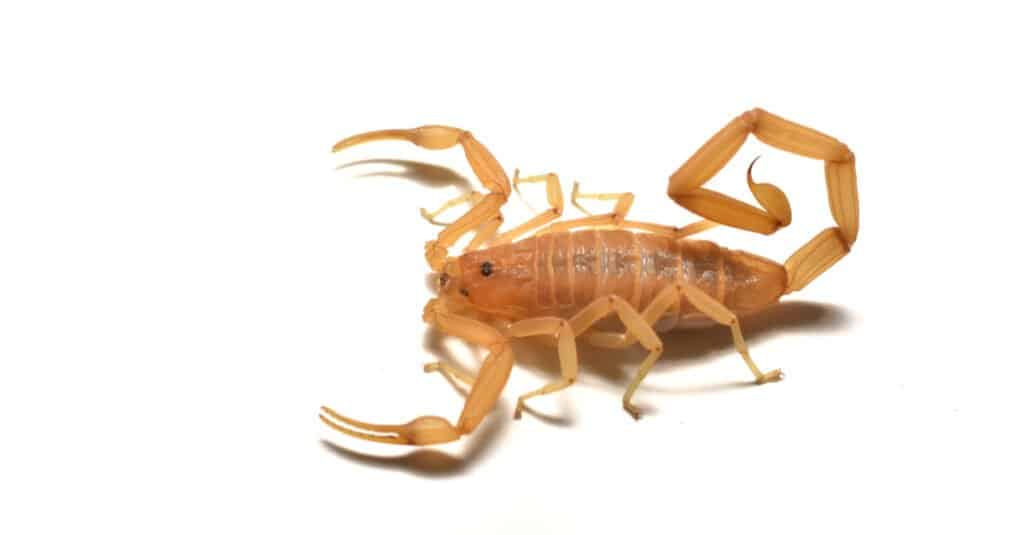If you struggle with arachnophobia, coming across a cane spider in Hawaii might turn your tropical vacation into a nightmare. However, despite their large size, extraordinary hunting skills, and speed, these spiders are not nearly as terrifying as you might think. Cane spiders are the largest spiders found on the Hawaiian Islands, but just how big are they?
A Little Background on the Cane Spider

Pantropical huntsman spiders (cane spiders) can measure nearly 12 centimeters long with their legs extended
©© 2017 Jee & Rani Nature Photography / CC BY-SA 4.0 via Wikimedia Commons – License
The Cane Spider (Heteropoda venatoria) comes from the Sparassidae family (huntsman spiders), which are known for their speed and agility. This spider has several different nicknames, such as the Banana Spider, Large Brown Spider, Giant Crab Spider, Laya, Brown Huntsman, and Pantropical Huntsman. In Hawaii, however, it is typically referred to as the Cane Spider. These spiders live in tropical and subtropical regions and are found on all the Hawaiian Islands.
Cane spiders are sensitive to cold temperatures, so they tend to hide in warmer areas and are often found inside houses, sheds, and barns. They also live in banana plantations, avocado groves, and forests. When cane spiders are found in banana plantations, they are sometimes referred to as “banana spiders.” This can get a bit confusing though, since there is another banana spider in Hawaii—the Hawaiian Garden Spider (although this spider’s name is due to its yellow color). The cane spider’s favorite habitat in Hawaii, however, are sugar cane fields, which is where they get their name.
How Big Are Cane Spiders in Hawaii?
The Hawaiian Cane Spider is the largest spider in Hawaii. For many years posts have circulated around the internet about the “Giant Hawaiian Cane Spider” that apparently can grow up to six feet in length. However, this is a hoax, and there is no such spider! The real Hawaiian Cane Spider, however, can grow as large as 4-6 inches!
What Do Cane Spiders Look Like?

In Hawaii Cane Spiders are sometimes just called “Large Brown Spiders.”
©foto76/Shutterstock.com
Cane spiders are large, somewhat hairy spiders that are usually tan, brown, reddish-brown, or grayish-brown. Their main body is ¾ to 1 inch long. However, including their legs these spiders can measure up to 4-6 inches wide! Cane spiders have exceptionally long, thick legs covered with black spots. The black spots on their legs mark where wiry hairs protrude like tiny thin spines. From a distance a cane spider might be mistaken for a tarantula or a wolf spider because of its long hairy legs. Female cane spiders have larger abdomens than males, but male spiders have longer legs.
Like most spiders, cane spiders have eight eyes. These are positioned on the front of the head in two rows, with a yellowish or creamy band below and behind their eyes. Cane Spiders have dark brown or black patterns on the cephalothorax (the combined head and thorax), and a few faint markings on the abdomen. Their bodies are also flat, which allows them to squeeze into small spaces, like cracks in trees and under bark.
When courting a female, a male cane spider will plant his feet firmly on the ground and vibrate his abdomen to make a humming or light buzzing sound. Female spiders lay between 100-400 eggs, which they carry in a small egg sac. Since they don’t spin webs, the female cane spider carries the egg sac in her pedipalps for about a month. During this time the mother spider does not hunt or eat anything, allowing her to solely focus on protecting her spiderlings. Even after the spiderlings emerge from the egg sac, their mother will continue to protect them until they are large enough to find food on their own
Are Cane Spiders Dangerous?

Although they are large and intimidating, Cane Spiders in Hawaii are valued pest controllers and do not attack humans.
©iSKYDANCER/Shutterstock.com
Although cane spiders are large, extremely fast, and very skillful hunters, they are not aggressive or dangerous to humans. In fact, cane spiders are extremely timid and shy. If they are threatened or exposed, they will sprint away with lightning speed. Accidentally discovering a cane spider in your home can be shocking of course, since they are so large and move quickly. Some people have been quite stunned when picking up a towel off the bathroom floor, only to find a cane spider speeding away from the scene.
Cane spiders rarely bite humans, preferring to run and hide rather than defend. They do not need to stay and defend because they are extremely fast spiders. Cane spiders can bite, but they only do so in self-defense or when they are extremely provoked. They are venomous so their small bites are quite painful and can cause a mild headache and swelling for a few hours.
The active chemical in cane spiders’ venom is the HpTX2 toxin, a chain of amino acids, i.e., protein building blocks. They block potassium channels in the human body.
With their shy nature and ability to flatten their bodies, these spiders are prone to hiding behind picture frames on the wall, under furniture, and in cupboards, cracks, and other small areas. Just be sure to check your shoes before putting them on, and you should be fine.
What do Cane Spiders Eat?

Cane Spiders are so big that they can sometimes eat scorpions and small bats.
©Tobias Hauke/Shutterstock.com
Cane spiders do not spin webs like many other spiders. These spiders are extremely fast and agile, allowing them they ambush and catch their prey directly. Cane spiders hunt at night and eat insects, especially butterflies and moths. They also eat common household pests like silverfish and cockroaches. They have even been known to eat bats and scorpions.
Cane Spiders: The Ultimate Natural Pest Control
Cane spiders are harmless and can make great house companions. In many places, they are highly valued because they will eat just about any pesky insect around. These spiders are natural pest controllers, and since they do not make webs, there are no messes to clean up around the house! If you find a cane spider in your house, you can leave it alone to continue its efficient exterminating. However, if you prefer to keep spiders out of your home, you can also carefully let it back outside.
Cane Spiders and Mistaken Identity: Cane Spider vs. Brown Recluse

Even though it has extremely dangerous venom, the brown recluse actually has incredibly small fangs compared to most spiders.
©Physics_joe/Shutterstock.com
Some often mistake a cane spider for the much more dangerous brown recluse spider. However, the cane spider is harmless and quite beneficial, so it is helpful to know how to identify this spider. While both cane spiders and brown recluse spiders are brown and hairy, there are some distinct differences:
- Cane spiders are much bigger than brown recluse spiders. The body and legs of a cane spider can be 4 to 6 inches long. A brown recluse spider is only 1 to 1½ inches long.
- Cane spiders have eight eyes, positioned on the front of the face in two rows of four. Brown recluse spiders, on the other hand, only have six eyes. These are positioned in three pairs of two in a semicircle on the front of their heads.
- Cane spiders do not build webs. The brown recluse spider builds a silk web (although it does not use it to catch prey).
- Cane spiders have dark markings on their heads and abdomens, as well as black spots along their legs with wiry spine-like hairs. Brown recluse spiders do not have any distinctive spots, stripes, or banded markings on their bodies or legs. Some may have a violin-shaped pattern on the head, but it is not always very clear.
- Cane spiders are found on all of the Hawaiian Islands, whereas brown recluse spiders are not typically found in Hawaii.
The photo featured at the top of this post is © bierchen/Shutterstock.com
Thank you for reading! Have some feedback for us? Contact the AZ Animals editorial team.






